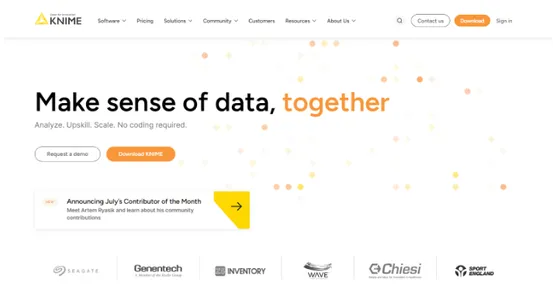Introduction
As business data is growing more complicated with each passing day, advanced methods for understanding it are required. Traditional data analysis methods relied heavily on manual processes and limited computational capabilities. However, a new era has dawned with the emergence of AI tools. These advanced tools harness the power of machine learning and deep learning algorithms to extract valuable insights, automate repetitive tasks, and uncover hidden patterns in vast datasets. By leveraging AI, data analysts can now tackle complex problems more efficiently and with greater accuracy, revolutionizing the field of data analysis. In this article, we will explore the top 10 AI tool for data analysis.
Table of contents
What is AI Data Analysis?
AI data analysis refers to applying artificial intelligence (AI) techniques and algorithms to process, interpret, and derive meaningful insights from large and complex datasets. It uses machine learning, deep learning, and other AI technologies to automate analysis, identify patterns, and make predictions or classifications. AI data analysis enables organizations to extract valuable information from vast data more efficiently and accurately. By leveraging AI capabilities, such as natural language processing, image recognition, and anomaly detection, businesses can gain a deeper understanding, make data-driven decisions, and unlock hidden opportunities for growth and optimization..
How to Use AI for Data Analysis?
By following these steps, data analysts can harness the power of AI tools, enabling them to gain valuable insights, make informed decisions, and drive innovation and growth:
Define Objectives
Clearly define the objectives of your data analysis project. Identify the specific insights or outcomes you want to achieve through AI-driven analysis.
Data Collection and Preparation
Gather relevant data from various sources and ensure it is clean, well-structured, and suitable for analysis. This may involve data cleaning, transformation, and normalization.
Select AI Techniques
Determine which AI techniques and algorithms are most appropriate for your analysis goals. Consider machine learning algorithms, deep learning models, natural language processing, or computer vision techniques based on the nature of your data and analysis requirements.
Model Training and Evaluation
Use labeled or historical data to train your AI models. Use suitable evaluation metrics to assess the model’s performance and iterate on the training process if necessary.
Feature Extraction and Engineering
Extract relevant features from the data or engineer new features to enhance the model’s predictive power. This step may involve dimensionality reduction, feature scaling, or the creation of new variables.
Model Deployment
Deploy the trained AI models in a production environment where they can analyze new, incoming data. Ensure the models are integrated seamlessly with your existing infrastructure and systems.
Interpret and Validate Results
Analyze the output of the AI models and interpret the results. Validate the findings against domain knowledge and conduct statistical tests or validation procedures to ensure accuracy and reliability.
Communicate and Visualize Insights
Present the insights and findings clearly and understandably using data visualization techniques. Use charts, graphs, and dashboards to effectively convey complex information to stakeholders.
Continuously Improve and Refine
Regularly monitor and update your AI models to account for changing data patterns and business requirements. Incorporate feedback from users and stakeholders to refine the analysis process.
Ethical Considerations
Consider ethical considerations and potential biases in the data or AI models. Ensure privacy, fairness, and transparency in data handling and analysis.
The Relationship Between AI and Data Analysis
The advent of artificial intelligence (AI) has revolutionized data analysis. Unlike traditional methods that required manual effort and time, AI data analysis expedites the process, offering real-time insights and predictive capabilities. AI algorithms efficiently process vast datasets, uncovering patterns and anomalies. These tools ensure a high level of consistency and accuracy, difficult to achieve manually. By employing machine learning and deep learning models, AI data analytics continuously adapt and learn from new data, refining analysis methods for up-to-date insights.
Top 10 AI Data Analysis Tools
These AI data analysis tools can help you derive better insights in your next project:
- RapidMiner
- Tableau
- Microsoft Azure Machine Learning
- KNIME
- Google Cloud AutoML
- PyTorch
- DataRobot
- Talend
- H2O.ai
- IBM Watson Analytics
RapidMiner
Rapidminer has an intuitive user interface with a drag-and-drop framework generator to streamline data analysis for individuals with various skill sets. It supports the data teams throughout the analytics cycle. It has integration and machine learning features that can help businesses access, load, and analyze data. You can analyze all forms of data, including texts, photos, and audio files, with RapidMiner.
Price: Free with limited features

Tableau
Tableau provides dynamic dashboards and easy data visualization, making exploring and presenting data visually simple. Users can utilize Ask Data, an AI-powered feature, to pose queries in simple terms and get quick graphic responses. Users can engage with their data without the requirement for coding.
Pricing: Starting from $12 per month.

Microsoft Azure Machine Learning
This AI tool for data analysis is cloud-based and offers versatility and capacity for data processing activities of different kinds and complexity. It is designed to help data scientists and machine learning experts utilize their current modeling and data processing skills. The integration with additional Azure services enables businesses to build comprehensive AI solutions that address specific business requirements.
Price: Free with limited features. $9.99 per month for all features.

KNIME
KNIME is an open-source solution that offers a complete toolkit for analyzing data, including records planning, device orientation, and visualization.It provides a variety of data science requirements with a full suite of AI-powered tools, including machine learning, predictive modeling, ETL, and spreadsheet automation.
Pricing: Free trial. Contact for higher versions.

Google Cloud AutoML
Google Cloud AutoML contains numerous components that allow you to develop ML models in an organized and accessible manner. Users can create unique machine-learning models using this user-friendly interface without requiring major coding experience. It is helpful for businesses that would like to test several ML methods and models to determine what approach best suits their requirements.
Pricing: Free trial.

PyTorch
PyTorch is an all-inclusive framework for creating deep learning models, a subset of machine learning widely utilized for tasks like language processing and picture identification. Its extensive tool and library sets cover everything from computer vision to learning by reinforcement. Leading cloud service providers extensively back it.
Pricing: Starts from $0.07.

DataRobot
DataRobot accelerates model-building by automated machine-learning capabilities, which do not require operator interaction. It enables businesses to operate on any blend of public clouds, data centers, or at the edge while providing management to protect and preserve their business. The tool’s powerful AI algorithms enable data-driven decision-making while offering precise predictions.
Pricing: Free for trial.

Talend
Talend is a comprehensive platform for data integration, monitoring, and administration and may be used for any data source or structural layout. You may manage and assess data on various big data channels, such as Hadoop, Spark, or Hive, with Talend. It can be trusted to maintain security and compliance while enabling precise insights and enhanced predictions.
Pricing: Free demo

H2O.ai
H2O.ai is an open-source, in-memory, shared ML and predictive analytics platform that allows you to design and deploy ML models. Its automated machine learning features allow consumers to swiftly create and implement models without requiring major data science skills. The analysis of massive datasets is made efficient through scalability and performance upgrades.
Pricing: Free

IBM Watson Analytics
IBM Watson Analytics is a cloud-based service that provides powerful data mining and predictive analytics for business users. It helps users find associations and patterns in their data by using automated insights and identifying trends. By utilizing the effectiveness of AI algorithms, predictive modeling enables consumers to generate data-driven decisions.
Pricing: Free trial.

Conclusion
We hope you liked our article on AI tools for data analysis. Let us know your thoughts in the comment section below.
These advanced tools, powered by machine learning and deep learning algorithms, enable efficient processing, interpretation, and extraction of valuable insights from large and complex datasets. From enhanced efficiency to improved accuracy and scalability, the benefits of AI in data analysis are undeniable. As technology advances, leveraging AI tools will become increasingly vital for businesses to stay competitive and harness the full power of their data.
If you want to learn how to use these simple tools to make data-driven decisions, then our course on No Code AI can help you do that. Explore the course today!
Frequently Asked Questions
A. Some of the best AI tools for data analysis include Tableau, Power BI, Monkey Learn and Akkio.
A. Yes, there are many AI tools for data analysis. Some of the best ones in the market are RapidMiner, Tableau, Google Cloud AutoML, PyTorch, DataRobot, Talend, H2O.ai and IBM Watson Analytics.
A. The best AI tools for Excel are Lumelixr AI, Zoho Sheets, Sheet AI and Numerous AI.

